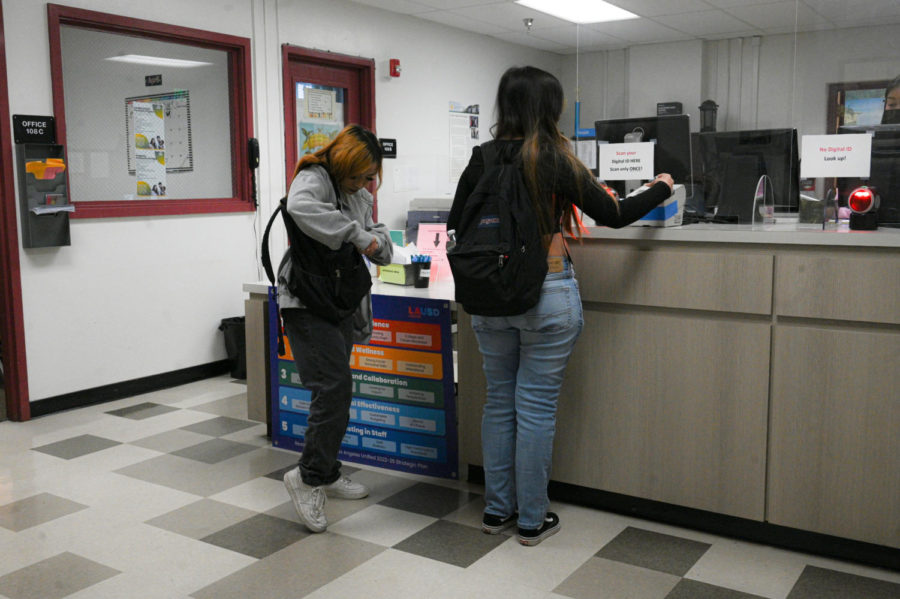The abridged version of this article appeared in the June. 2023 print edition of The Mirror. This is an uncut version.
Emmanuella Akinleye, a freshman, found her breaths shortening while her thighs burned. It was freezing cold outside, but that was the least of her worries right now.
She sprinted towards the main building’s doors, acutely aware that lateness was inevitable. Her usually reliable bus was delayed, and all she could do was await its arrival.
Glancing at her phone, panic set in when she saw 8:31 a.m. on the screen. As she looked up, a long line of nonchalant students awaited their tardy passes. Their leisurely pace suggested little concern for tardiness, adding an estimated 10 minutes to her delay.
Upon entering her first-period biology class, Akinleye handed her tardy slip to the teacher. Marked 8:42, it caught the attention of her fellow students as the door clicked behind her. Their focus shifted from the complexities of meiosis to her tardiness, despite her being only a minute late to school. She was left to bear their penetrating stares.
“It’s unfair,” she said, exasperated. “If I’m already at school by 8:31, there’s no point in getting marked as tardy.”
This year, administrators have put a strong emphasis on the school’s attendance and tardy policies. However, students often view the consequences for non-compliance as excessively harsh.
According to the tardy policy, an automated phone call and email are sent home after a student’s first three tardies. If a student accumulates more than four, they must serve detention and their parent is required to meet with a counselor to discuss the issue.
As for seniors, the policy allows up to ten unexcused absences. If this limit is exceeded, seniors lose eligibility for exclusive events such as prom, grad night, senior breakfast, and others.
While these potential consequences may appear intimidating, there are methods for students to clear their records. They can attend lunch detentions or participate in Saturday campus cleanup activities to reduce their absences and tardies.
Despite these facts, the school is taking extreme measures to emphasize the importance of attendance, indicating there’s more to it than simply desiring punctual and present students.
The shift to distance learning during the COVID-19 pandemic quickly normalized the practice of students simply rolling out of bed and logging in to school, all without the risk of tardiness.
During the first semester of the 2019-2020 school year, student absences totalled 6,895. This figure rose to 9,270 in the first semester of the following year.
The 2021-2022 school year saw the school lose $70.14 per absent student. Student absences last year resulted in a loss of around $2.5 million, with an average monthly loss of $234,060.
Assistant Principal Anabel Bonney noted that the rising numbers of student tardies and absences this year led the faculty to strictly enforce existing tardy policies with added penalties, hoping to inspire punctuality among students.
“We’ve actually always had a tardy policy, but the reason we’re coming down a bit hard on it right now is because students think they just run their own program,” she said.
For freshman Angie Velope, attendance holds significant importance.
“If you’re not in class, how are you going to get educated?” she questioned. “You only get educated when you’re actually in the classroom.”
It’s not just the school’s image that benefits from perfect attendance — it also bolsters its funding.
“The more students that attend, the more successful the school’s going to be,” according to Assistant Principal Ms. Dawn Brown.
Funding from the district is determined by the school’s attendance rates, with each student’s presence playing a crucial role. This serves as the district’s method of compensating the school for maintaining an attending student population.
“The school gets attendance money for every student in class,” Ms. Bonney said. “The district does give a little bit of money to the school as a way to say ‘Hey, you got students to come into school.’”
Funds earned from attendance rates are allocated towards school supplies, field trips and hiring additional counselors and teachers to decrease class sizes.
“There’s a little funding that the state gives to the school for attendance, and revenue is generated every time a student is in class,” Ms. Bonney said. “This is discretionary money that we can use to buy any instructional materials that the school can benefit from and distribute to our teachers and departments.”
Despite this, some students, like freshman Wyatt Lee, express doubts about the money being used for school improvement.
“The bathrooms are really out of date, there are cracks in the pavement and some of the air conditioning systems and heaters in my classrooms don’t work,” Lee said. “If they are making money off of attendance, I don’t know what they’re spending it on.”
Yet, the upkeep of school facilities falls under the jurisdiction of LAUSD, not the school itself. Therefore, funds gathered from student attendance can’t be used for repairs. Building repairs rely entirely on the district.
Funds generated through student attendance are funneled into an Instructional Materials Account (IMA), which is then distributed among all departments including science, math, history, English, PE, and electives.
“Every teacher gets a portion of that money that they can use to buy classroom supplies,” Ms. Bonney said. “The departments can also use it to purchase things for the classroom such as subscriptions to certain websites and programs that they may need. It depends on their needs, but all the money is spent to benefit the students in the classroom.”
In addition, Ms. Bonney pointed out that when a student skips class, the school loses a portion of its funding. Thus, chronic absenteeism could seriously affect the school’s finances, potentially leading to staff reductions.
Moreover, the district is proactive in spotting patterns and taking initial steps to maintain attendance.
“If the district knows that multiple students or teachers will be absent because of a religion or culture, the district will make that day an off day,” Ms. Bonney said. “So instead of losing money for that day, the funds are completely unaffected because it was a day off.”
This is the reason behind the numerous holidays marked as “Unassigned Days” on the school calendar.
After learning about the financial implications of student attendance rates, some students express uncertainty. They question if a teacher’s push for better attendance is truly for the students’ benefit, or simply a means to secure payment.
However, Ms. Bonney underscores that the school’s intentions are purely to motivate regular attendance.
“Teachers will get paid regardless of if the students show up or not,” she clarified. “However, if too many students are absent, it is the responsibility of the teacher to encourage the students to come to school, make phone calls home, and to inform the administration of any attendance concerns they may have because the student is missing too many school days.”
Yet, there is a looming risk. If attendance rates continue on a downward trend, resulting in lost enrollment, the school may face teacher layoffs in the subsequent academic year.



